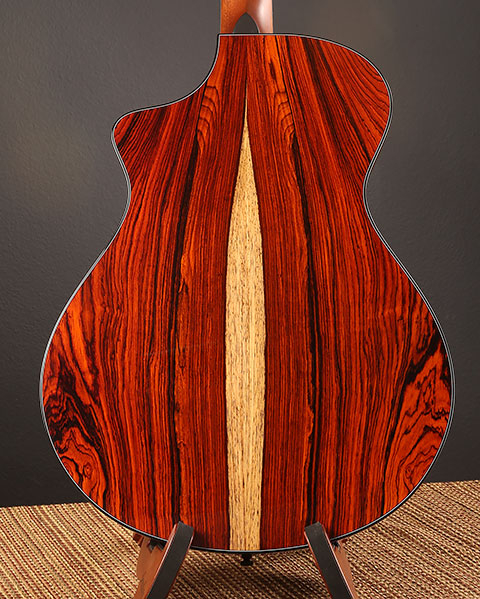
Are you a rosewood player or a mahogany player?
Once upon a time, those were your options.
“If you wanted that classic U-shaped tone, with the mids scooped so your voice could sit in the middle, between the bass and the treble, you went for rosewood,” says Breedlove owner Tom Bedell. “If you wanted the guitar to accompany your voice, to ride alongside it, if you wanted that midrange to be right there with you, you went for mahogany.”
“And the truth was,” he laughs, “if you had a mahogany, your dream was to get a rosewood. And if you owned a rosewood, your dream was to get a mahogany!”
But there’s more to life—and more to the world of exotic tonewoods—than just the old standbys.
Bedell keeps the original Breedlove, designed by Larry Breedlove himself, in his office. It’s got walnut back and sides.
“We ventured deep into exotic tonewoods from the very beginning,” says Breedlove designer Angela Christensen, who has been with the brand for 17 years. “Cocobolo, ziricote, kauri, bubinga, koa, Australian blackwood, Port Orford cedar … They all have their own voice and have really found a place within our quiver because we have always been all about the detail and the quality within the specific elements of our designs and our guitars.”
“The idea that Breedlove is non-traditional in every way goes right to the core,” says Bedell. “Anything's up for grabs. We want to do design work that is way more visually appealing, we want to do varieties of woods that are way more interesting, and we want to be able to do nuances in tonality and sound that are non-traditional. That's really been the Breedlove mantra from the beginning. I heard that, I didn't create that.”
What’s different about the company’s philosophy now, in 2019, Christensen points out, boils down to two things: wood sourcing and Sound Optimization. The former makes you feel good about where your guitar comes from. The latter makes you feel better about how it sounds.
“When Tom came in and purchased the company and shared his passion for sourcing the wood to meet all of our current tonewood certification program requirements, it really got us closer to people that share our dedication,” says Christensen. “We have great relationships with all of our wood suppliers, and they are all passionate about what we do at Breedlove. We know they are doing it right and it makes them feel good that people care about the sourcing for our guitars.”
“With Sound Optimization,” she continues, “you become so much more intimate with the wood, because you are learning more about it on a different level. There are some woods that we've had to change how we work with, especially some of the lighter density ones like maple, mahogany, koa, walnut and even myrtle. We process them differently now, in order to maximize the Sound Optimization process—everything from how we break them down to how we fine tune them.”
Christensen is an avowed fan of myrtlewood, particularly, the whole shooting match—“Yeah, the top, back and sides combo is my favorite.”
Myrtle, natively grown within the same Oregon state line as Bend, isn’t technically an exotic tonewood, but it might as well be. No one was using it before Breedlove.
It just sings. Try one and you’ll see.
Cocobolo’s another great choice, vivid and beautiful, sonically and visually.
“In the past,” laughs Bedell, “if you didn't really care about sound, but you cared a whole lot about looks, you might've built a cocobolo guitar. Today, we will sand that Cocobolo to about 60 percent of the thickness of what we would sand mahogany. That allows cocobolo to perform musically in the way that nature intended it to perform. That guitar will sound absolutely incredible because you've got that great density, but we can make it thin enough to really vibrate. Cocobolo is part of the rosewood family, and you can almost argue that, built correctly, a cocobolo guitar sounds as good as, or better, than a Brazilian rosewood guitar. That’s because we’ve learned how to use it to its full musical potential.”
“The breakthrough in exotic woods for Breedlove has been, in the last two years, with how we've been applying Sound Optimization. We are able to take each exotic tonewood to its truest physical capability.”
“It’s so nice to have a wide palette to work with,” says Christensen, “just like a painter’s palette with colors. It gives you the ability to really individualize and hone in on several characteristics that give beauty to the beholders eye and the listener’s ear.”
